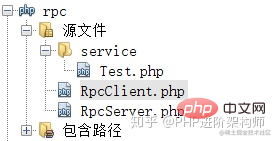 Backend Development
Backend Development
 PHP Tutorial
PHP Tutorial
 Analyze how PHP can quickly create RPC services (code demonstration)
Analyze how PHP can quickly create RPC services (code demonstration)
Analyze how PHP can quickly create RPC services (code demonstration)
This article will introduce to you what RPC is and how to use PHP to create an RPC service simply and quickly. It is actually very simple. Let’s take a look~ I hope it will be helpful to friends in need~

RPC stands for Remote Procedure Call, which translates to "remote procedure call". Mainly used for remote communication and mutual calls between different systems. [Recommended learning: PHP video tutorial]
For example, there are two systems, one is written in PHP and the other is written in JAVA, and PHP wants to call a certain class in JAVA For a certain method, RPC needs to be used at this time.
How to adjust? Direct adjustment is impossible. PHP can only request JAVA's services through some custom protocol. JAVA parses the protocol, instantiates the class locally and calls the method, and then returns the result to PHP.
Here we use PHP's socket extension to create a server and client to demonstrate the calling process.
RpcServer.php code is as follows:
<?php
class RpcServer {
protected $serv = null;
public function __construct($host, $port, $path) {
//创建一个tcp socket服务
$this->serv = stream_socket_server("tcp://{$host}:{$port}", $errno, $errstr);
if (!$this->serv) {
exit("{$errno} : {$errstr} \n");
}
//判断我们的RPC服务目录是否存在
$realPath = realpath(__DIR__ . $path);
if ($realPath === false || !file_exists($realPath)) {
exit("{$path} error \n");
}
while (true) {
$client = stream_socket_accept($this->serv);
if ($client) {
//这里为了简单,我们一次性读取
$buf = fread($client, 2048);
//解析客户端发送过来的协议
$classRet = preg_match('/Rpc-Class:\s(.*);\r\n/i', $buf, $class);
$methodRet = preg_match('/Rpc-Method:\s(.*);\r\n/i', $buf, $method);
$paramsRet = preg_match('/Rpc-Params:\s(.*);\r\n/i', $buf, $params);
if($classRet && $methodRet) {
$class = ucfirst($class[1]);
$file = $realPath . '/' . $class . '.php';
//判断文件是否存在,如果有,则引入文件
if(file_exists($file)) {
require_once $file;
//实例化类,并调用客户端指定的方法
$obj = new $class();
//如果有参数,则传入指定参数
if(!$paramsRet) {
$data = $obj->$method[1]();
} else {
$data = $obj->$method[1](json_decode($params[1], true));
}
//把运行后的结果返回给客户端
fwrite($client, $data);
}
} else {
fwrite($client, 'class or method error');
}
//关闭客户端
fclose($client);
}
}
}
public function __destruct() {
fclose($this->serv);
}
}
new RpcServer('127.0.0.1', 8888, './service');RpcClient.php code is as follows:
<?php
class RpcClient {
protected $urlInfo = array();
public function __construct($url) {
//解析URL
$this->urlInfo = parse_url($url);
if(!$this->urlInfo) {
exit("{$url} error \n");
}
}
public function __call($method, $params) {
//创建一个客户端
$client = stream_socket_client("tcp://{$this->urlInfo['host']}:{$this->urlInfo['port']}", $errno, $errstr);
if (!$client) {
exit("{$errno} : {$errstr} \n");
}
//传递调用的类名
$class = basename($this->urlInfo['path']);
$proto = "Rpc-Class: {$class};" . PHP_EOL;
//传递调用的方法名
$proto .= "Rpc-Method: {$method};" . PHP_EOL;
//传递方法的参数
$params = json_encode($params);
$proto .= "Rpc-Params: {$params};" . PHP_EOL;
//向服务端发送我们自定义的协议数据
fwrite($client, $proto);
//读取服务端传来的数据
$data = fread($client, 2048);
//关闭客户端
fclose($client);
return $data;
}
}
$cli = new RpcClient('http://127.0.0.1:8888/test');
echo $cli->hehe();
echo $cli->hehe2(array('name' => 'test', 'age' => 27));Then run the above two scripts respectively (note that php needs to add environment variables)
> php RpcServer.php > php RpcClient.php
The results are as follows:


Test.php code is as follows:
<?php
class Test {
public function hehe() {
return 'hehe';
}
public function hehe2($params) {
return json_encode($params);
}
}The directory structure is as follows:

Our customized protocol above can be modified at will, as long as the client and server can be unified and parsed.
The client passes the class, method and parameters to be called to the server by requesting the server, and the server returns the result by instantiating the calling method.
The above is the detailed content of Analyze how PHP can quickly create RPC services (code demonstration). For more information, please follow other related articles on the PHP Chinese website!

Hot AI Tools

Undresser.AI Undress
AI-powered app for creating realistic nude photos

AI Clothes Remover
Online AI tool for removing clothes from photos.

Undress AI Tool
Undress images for free

Clothoff.io
AI clothes remover

Video Face Swap
Swap faces in any video effortlessly with our completely free AI face swap tool!

Hot Article

Hot Tools

Notepad++7.3.1
Easy-to-use and free code editor

SublimeText3 Chinese version
Chinese version, very easy to use

Zend Studio 13.0.1
Powerful PHP integrated development environment

Dreamweaver CS6
Visual web development tools

SublimeText3 Mac version
God-level code editing software (SublimeText3)

Hot Topics
 1665
1665
 14
14
 1424
1424
 52
52
 1322
1322
 25
25
 1269
1269
 29
29
 1249
1249
 24
24
 PHP and Python: Comparing Two Popular Programming Languages
Apr 14, 2025 am 12:13 AM
PHP and Python: Comparing Two Popular Programming Languages
Apr 14, 2025 am 12:13 AM
PHP and Python each have their own advantages, and choose according to project requirements. 1.PHP is suitable for web development, especially for rapid development and maintenance of websites. 2. Python is suitable for data science, machine learning and artificial intelligence, with concise syntax and suitable for beginners.
 PHP in Action: Real-World Examples and Applications
Apr 14, 2025 am 12:19 AM
PHP in Action: Real-World Examples and Applications
Apr 14, 2025 am 12:19 AM
PHP is widely used in e-commerce, content management systems and API development. 1) E-commerce: used for shopping cart function and payment processing. 2) Content management system: used for dynamic content generation and user management. 3) API development: used for RESTful API development and API security. Through performance optimization and best practices, the efficiency and maintainability of PHP applications are improved.
 PHP: A Key Language for Web Development
Apr 13, 2025 am 12:08 AM
PHP: A Key Language for Web Development
Apr 13, 2025 am 12:08 AM
PHP is a scripting language widely used on the server side, especially suitable for web development. 1.PHP can embed HTML, process HTTP requests and responses, and supports a variety of databases. 2.PHP is used to generate dynamic web content, process form data, access databases, etc., with strong community support and open source resources. 3. PHP is an interpreted language, and the execution process includes lexical analysis, grammatical analysis, compilation and execution. 4.PHP can be combined with MySQL for advanced applications such as user registration systems. 5. When debugging PHP, you can use functions such as error_reporting() and var_dump(). 6. Optimize PHP code to use caching mechanisms, optimize database queries and use built-in functions. 7
 The Enduring Relevance of PHP: Is It Still Alive?
Apr 14, 2025 am 12:12 AM
The Enduring Relevance of PHP: Is It Still Alive?
Apr 14, 2025 am 12:12 AM
PHP is still dynamic and still occupies an important position in the field of modern programming. 1) PHP's simplicity and powerful community support make it widely used in web development; 2) Its flexibility and stability make it outstanding in handling web forms, database operations and file processing; 3) PHP is constantly evolving and optimizing, suitable for beginners and experienced developers.
 PHP vs. Python: Understanding the Differences
Apr 11, 2025 am 12:15 AM
PHP vs. Python: Understanding the Differences
Apr 11, 2025 am 12:15 AM
PHP and Python each have their own advantages, and the choice should be based on project requirements. 1.PHP is suitable for web development, with simple syntax and high execution efficiency. 2. Python is suitable for data science and machine learning, with concise syntax and rich libraries.
 PHP and Python: Code Examples and Comparison
Apr 15, 2025 am 12:07 AM
PHP and Python: Code Examples and Comparison
Apr 15, 2025 am 12:07 AM
PHP and Python have their own advantages and disadvantages, and the choice depends on project needs and personal preferences. 1.PHP is suitable for rapid development and maintenance of large-scale web applications. 2. Python dominates the field of data science and machine learning.
 PHP vs. Other Languages: A Comparison
Apr 13, 2025 am 12:19 AM
PHP vs. Other Languages: A Comparison
Apr 13, 2025 am 12:19 AM
PHP is suitable for web development, especially in rapid development and processing dynamic content, but is not good at data science and enterprise-level applications. Compared with Python, PHP has more advantages in web development, but is not as good as Python in the field of data science; compared with Java, PHP performs worse in enterprise-level applications, but is more flexible in web development; compared with JavaScript, PHP is more concise in back-end development, but is not as good as JavaScript in front-end development.
 PHP and Python: Different Paradigms Explained
Apr 18, 2025 am 12:26 AM
PHP and Python: Different Paradigms Explained
Apr 18, 2025 am 12:26 AM
PHP is mainly procedural programming, but also supports object-oriented programming (OOP); Python supports a variety of paradigms, including OOP, functional and procedural programming. PHP is suitable for web development, and Python is suitable for a variety of applications such as data analysis and machine learning.



